Jean-Baptiste Oudry, The rhino1749. Staatliches Museum Schwerin
It was 1741 when Clara – o Miss Clara as many called her – she landed in Holland from India, where she was born. After killing her mother during a hunting trip, a Bengali noble gave it to Jan Albert Sichterman, director of the Dutch East India Company, as a sign of friendship. For over two years she Clara she lived in the Dutch village with the Sichterman family, the children’s companion in games and frantic runs around the dining table. She then she became too big and heavy for domestic life. It was sold to Douwe Jans Mout, captain of a ship of the Company, and began his European adventure, far from the water and mud in which he loved to roll, perpetually traveling, exposed every day to the gaze of crowds of onlookers as an attraction. exotic and picturesque.
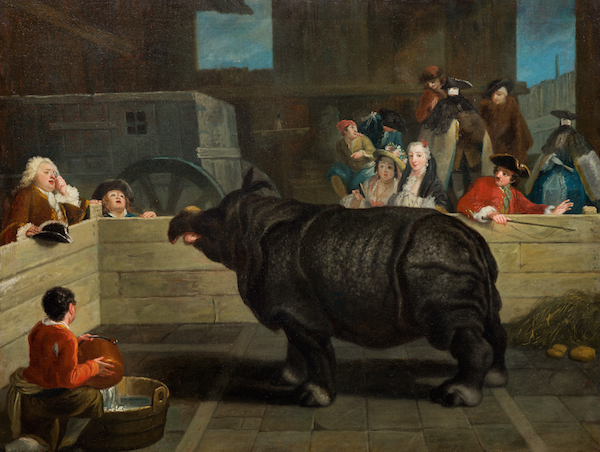
Venetian painter (previously attributed to Pietro Longhi), The rhinoceros (Clara in the enclosure), 1751. Gallerie d’Italia, Palazzo Leoni Montanari
Before Clara’s arrival, the rhinoceros was considered almost in Europe a mythological creature: some identified him with the unicorn, others imagined him fighting with elephants in the arenas of ancient Rome. Even a true nature artist like Albrecht Dürer his physiognomy was not very clear: in an engraving of 1515, he represented him with an additional horn on his back and skin similar to the armor of a soldier.
In 18 years Clara traveled Europe from Amsterdam to Vienna, from Paris to Venice, from Krakow to London, offering herself generously to the voracious eyes of the patrons of the fairs or to the craving for rarity of the court audience, posing for artists of every country and docilely allowing themselves to be examined by scientists in the grip of a fever of knowledge. And while naturalists argued about the classification to be given to the animal, in religious circles one wondered if the rhinoceros was actually Behemot, the evil beast who according to the Bible “feeds on grass, can swim, loves to roll in the mud, has strong legs and a sword in the shape of a horn,” just like Clara. Common to all, the wonder in front of such a rare and bizarre being, an enthusiasm that often bordered on hysteria. And if in 1754 the Prussian princess Wilhemina of Bayreuth reported that she felt “an extraordinary attraction like a rhino” under the hypnotized gaze of the subjects of her brother Frederick the Great, still in 1776 the philosopher Jean-Jacques Rousseau he replied to an overly insistent admirer that “if he wanted to see a rhino, he would have to go to the fair, and not to his house”.
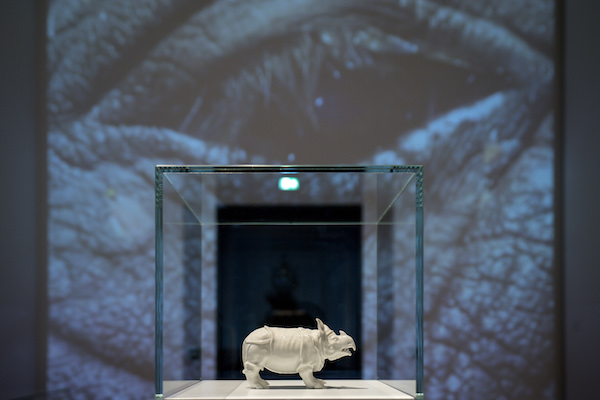
Clara, exhibition view at the Rijksmuseum, Amsterdam. Photo Olivier Middendorp
The exhibition at the Rijksmuseum accurately portrays the stages of Clara’s adventure and highlights her impact on the European collective imagination through rare and original works, many of which are on public display for the first time. Each object has a story to tell. A precious Indian miniature illustrates the tradition of rhino hunting, reserved for Mughal nobles, due to which Clara was left alone in the world, while a painting by Hendrick van Schuylenburgh shows the Dutch settlement where the rhinoceros grew up in close contact with humans. . Advertising flyers in many languages announce her arrival in the cities of the Old Continent, introducing a surprising variety of works of art dedicated to her. Delicate drawings on blue paper, for example, testify to the interest of the Venetian artist Francesco Lorenzi, who portrayed Clara in every detail and from different perspectives, perhaps on behalf of the master Giambattista Tiepolo. However, no specimen of rhinoceros has ever gone to keep company with the ranks of elephants, camels and exotic animals that populate the frescoes by the Venetian painter.
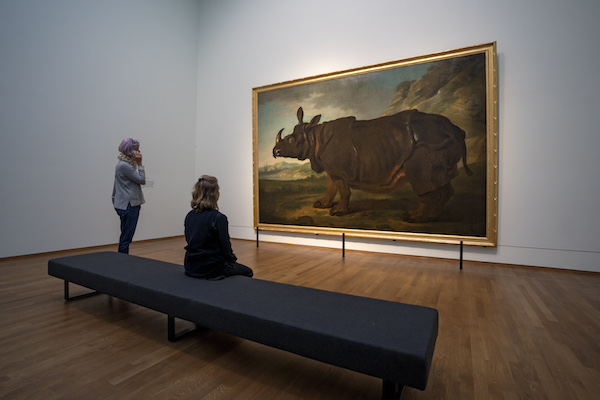
Clara, exhibition view at the Rijksmuseum, Amsterdam. Photo Olivier Middendorp
Impressive is the life size realistic portrait by Clara (3 x 4.5 meters) painted in Paris by the French Jean-Baptiste Oudry, with the rhino which, although represented in profile, seems to look the viewer in the eye. Originally intended for the palace of Versailles, the painting was exhibited at the Salon du Louvre in 1750, where it caused a lot of uproar. Finally he left for Germany, bought by the Duke of Mecklenburg-Schwerin for an exorbitant price.
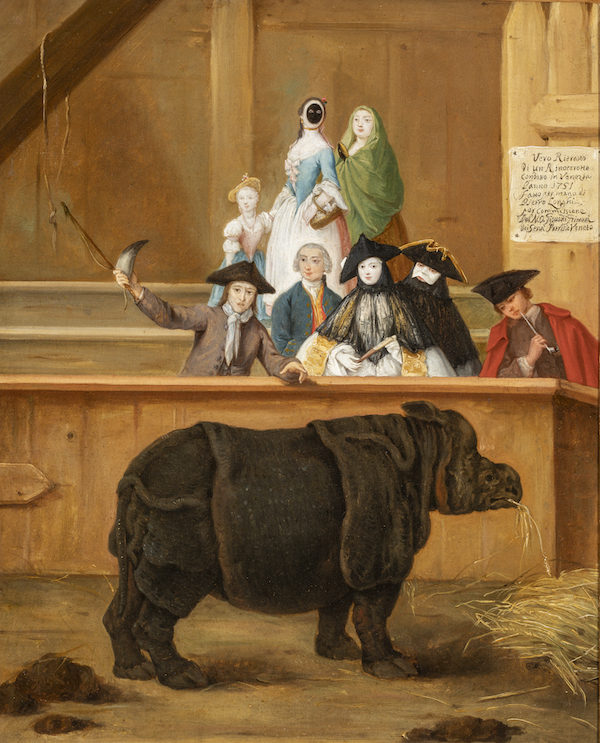
Pietro Longhi, The Rhinoceros, 1751. Foundation of the Civic Museums of Venice Ca ‘Rezzonico, Museum of the Venetian eighteenth century
Clara arrived in Venice during the Carnival and took his place a stone’s throw from Piazza San Marco, right in front of the Doge’s Palace. Master Pietro Longhi painted it on behalf of the patrician Giovanni Grimani, which appears in the background of the painting together with family members in masks. Locked in a cramped enclosure, the animal showed signs of nervousness and lost its horn, frightening guests and agitating businessmen: without its characterizing attribute, would the rhino still have been a profitable attraction? While in Longhi’s painting a young man waved his horn as a trophy, Clara was forced to leave quickly from Venice, where she was no longer welcome. Maria Luisa of ParmaInstead, she was so fascinated by the strange creature that she wanted it with her forever, as the pedestal of a showy clock that appears in the great portrait of the Duchess by Laurent Pecheux.
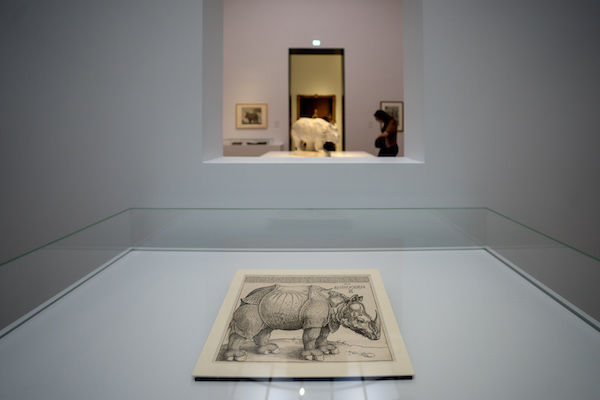
Clara, exhibition view at the Rijksmuseum, Amsterdam. Photo Olivier Middendorp
If Dürer’s precious sixteenth-century engraving exemplifies the lack of knowledge of the rhinoceros in Europe before Clara’s arrival, at the end of the exhibition an installation by the contemporary artist Rossella Biscotti expresses the disturbances aroused today by its history. Piles of Dutch bricks where the rhino’s profile is printed and tobacco leaves evoke colonial exploitation and power imbalances at the dawn of the globalized world where Clara, treated like any commodity, was quickly consumed in conditions unsuitable for her nature.
The reflections on Clara’s fate, however, are not unique to our time. Already in 1750 the German writer Cristoph Gottlieb Richter published the interesting Dialogue between a rhino and a locust. The rhinoceros is just Clara, the only example of her species known to the western public at the time. “In a radical reversal of perspective”, says the curator van der Ham, “the animal observes men and laughs at their arrogance. Tired of taking orders, of being stared at and groped constantly, he dreams of freeing himself from captivity, of returning home and finally exposing men to the gaze of rhinos who, unlike humans, would know how to look with genuinely benevolent eyes at the miracle of an unknown creature “.
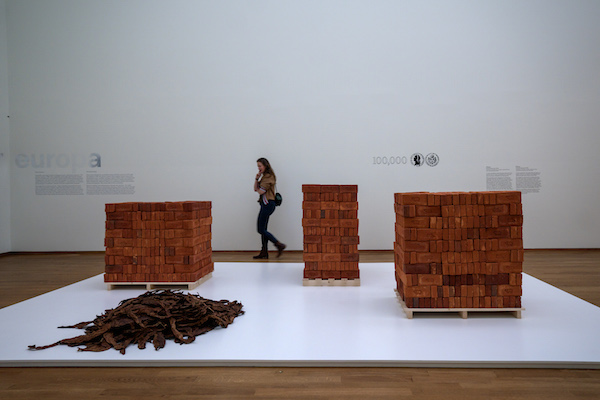
Clara, exhibition view at the Rijksmuseum, Amsterdam. Photo Olivier Middendorp

